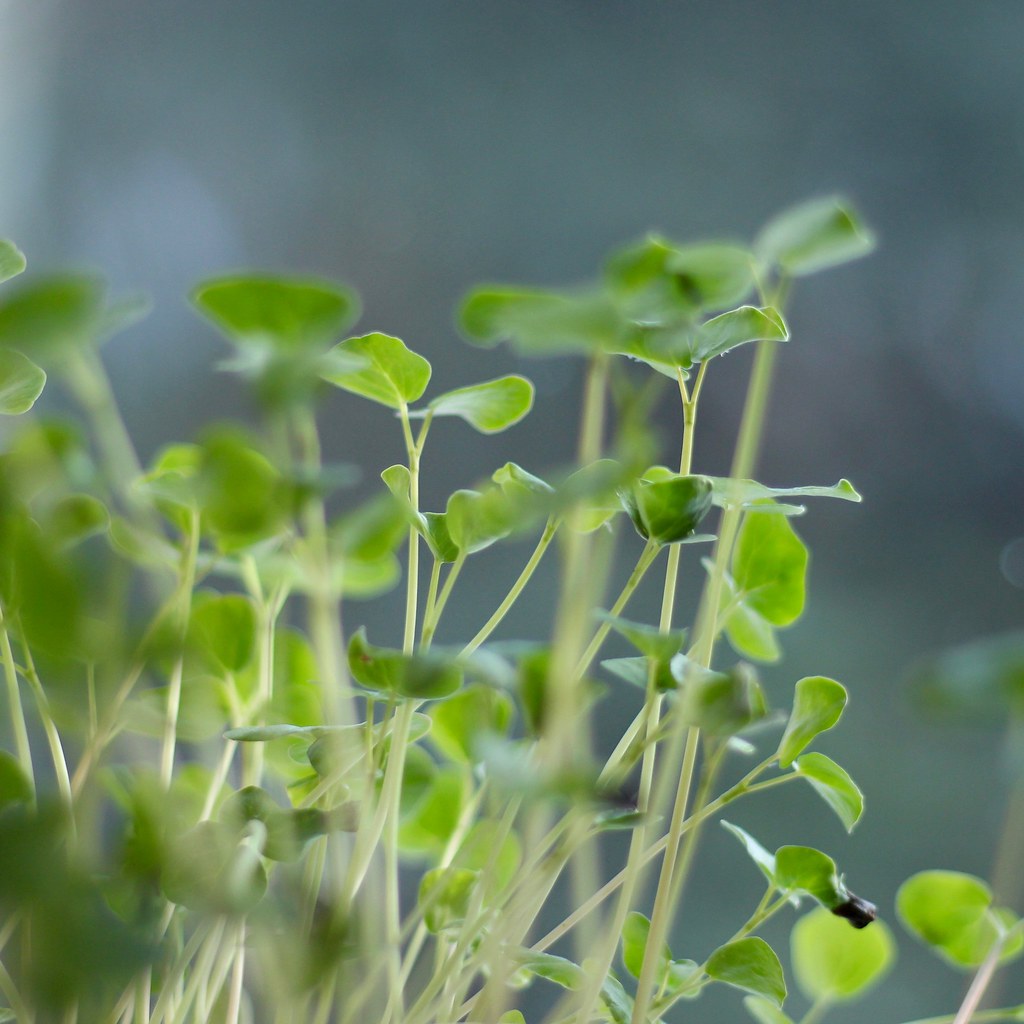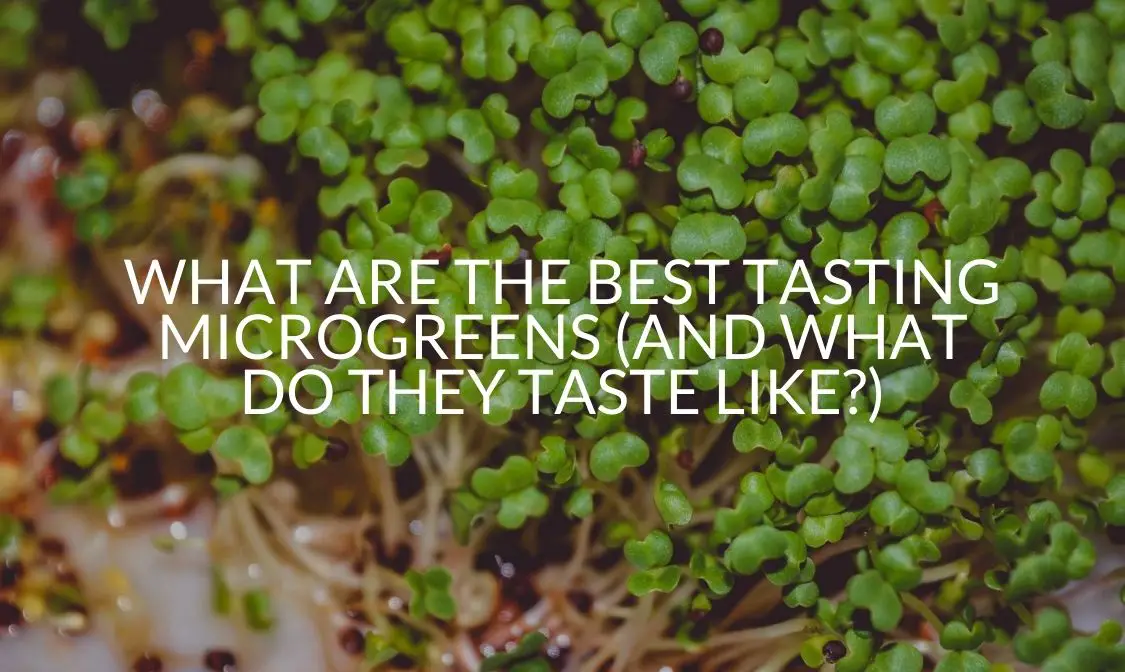Microgreens are wonderful! They’re healthy and have the capacity to treat many ailments, provide valuable nutrients and are easy to grow. But which ones taste the best? This is a loaded question, but that’s going to depend on your taste preferences.
Do Microgreens Taste Good?
Microgreens taste good and much like their mature versions. Many have a bit of a bitter flavor that adds a little spice and variety to salads and sandwiches. But, some microgreens have a horrid taste or can make you sick. For instance, Cantaloupe microgreens taste terrible and tomato microgreens can make you sick.
What Are The Best Tasting Microgreens (And What Do They Taste Like?)
You can grow almost anything as a microgreen. Some are going to be more bitter than others, with most having some level of bitterness. Here’s a list of 10 best-tasting microgreens:
1. Arugula
The crisp, tender, and succulent consistency of Arugula a rather mild taste compared to the mature herb. It has a sweet yet tangy flavor amid peppery, earthy and nutty undernotes. Try it in salads, soups, sandwiches, pasta or as a bed of greens under roasted meats and seafood.
(How To Grow Arugula Microgreens.)
2. Basil
Basil as a microgreen is amazing! Aromatic and full of flavor with intense green leaves, basil microgreens have a zesty yet sweet palette. Excellent with pasta sauces, soups, bruschetta and salads because of the fresh taste it provides.
(How To Grow Basil Microgreens.)
3. Beets
Microgreen beets are sweeter than their ground-grown versions. They’re earthy with some varieties offering a touch of spinach to its flavor. Try them in breakfast eggs or in a variety of different salads for good flavor and color variety.
4. Broccoli
Microgreen broccoli looks like a deep green and miniature version of this popular vegetable with a mild and slightly bitter taste that’s very crunchy and dense. Use it in salads, soups, smoothies and sandwiches along with quiches, omelets or other breakfast food that incorporates eggs.
(How To Grow Broccoli Microgreens.)
5. Dill
The straight, grass-like leaves of micro dill are aromatic with a faint grassy smell. They taste mild, herbal and citrusy with a sweet tangy under flavor. It adds a feathery texture as a garnish to seafood, eggs, potatoes, rice, poultry, grains and soups. Put micro dill in sandwiches or use it in at-home pickling.
(How To Grow Dill Microgreens.)
6. Garlic Chives
The tender and slender shoots of garlic chives microgreens taste like the name suggests, garlic! The flavor is distinct but mild and best-consumed right when the first true leaves form because that’s when it’s highest in flavor.
7. Mustard
Zestier than the mature mustard greens, microgreen mustard has a sweetish hot flavor. Some varieties also have a spicy horseradish taste to them. These work very well in salads, sushi or as a bed of greens for roast beef.
(How To Grow Mustard Microgreens.)
8. Pea
Pea microgreens have a sweet pea pod taste with an irresistible, tender crispiness. Use pea microgreens in salads, sandwiches and sauces. They are perfect for most Asian cuisines and dishes, like stir fry.
(How To Grow Pea Microgreens.)
9. Sunflower
Sunflower microgreens are a little taste of heaven in your mouth. They have the same flavor as sunflower seeds with a wonderfully addictive nutty, crunchiness that you won’t be able to stop munching on.
(How To Grow Sunflower Microgreens.)
10. Swiss Chard
Swiss chard microgreens have beautiful color and an interesting earthy flavor that sits between spinach and beets. They’re welcome on a salad with balsamic vinaigrette and mozzarella cheese.

FAQ
Which Microgreens Grow Fastest?
Microgreens grow to edibility within a matter of weeks. Their harvesting determines tastiness. Here are our top 10 best tasting microgreens organized by the fastest to the longest growing times:
Arugula – Five To Fourteen Days
Arugula is ready to harvest when the flavor and look meet your preferences. Start tasting the greens when the very first bright and open leaves appear. This should happen when they’re about two inches tall.
Garlic Chives – Six To Nine Days
Although slow to germinate, once garlic chives reach around two inches tall, they’re ready. Start tasting the foliage when leaves first appear so that it’s to your liking. Use your fingers to harvest above the soil line and don’t use scissors.
Broccoli – Six To Fifteen Days
Right before true leaves come in and the plants reach two to three inches tall, broccoli microgreens are ready to harvest. If you let them grow longer than that, the flavor will be drastically affected. Stop watering 12 hours prior to harvesting.
Mustard – Two To Six Weeks
The harvesting for mustard will vary depending on the variety. If you want a sweeter taste, harvest when cotyledons appear. But for a peppery, spicier flavor, allow it to grow until it the taste is to your liking. After cutting at soil level, mustard will regrow small, bittter-tasting leaves.
Swiss Chard – Eight To Ten Days
When the leaves are about six inches thick, your Swiss Chard’s ready for harvesting. Because the hulls provide a very bitter taste, you have to remove them so the greens taste milder.
Sunflower – Eight To Twelve Days
Sunflower microgreens are ready when they’re about three to four inches long with two cotyledons. Harvest right before the leaves mature or bitterness will result. Use clean, sharp scissors and clip above the soil line. These will not regrow after cutting.
Pea – Ten To Fourteen Days
When peas are tall, straight and about two inches tall, they’re harvest-ready. Peas regrow when cut higher, but you can opt to harvest when cotyledons appear. Use shears when they’re around three to four inches tall above the soil line. Or, harvest later and cut the top portion.
Basil – Ten To Twenty Days
You should harvest basil microgreens when cotyledons appear. Stop watering about eight hours before so they dry out a bit. Grab clean sheers and cut in bunches above the soil.
Beets – Ten To Twenty Eight Days
Harvest time for beets will depend on the variety. They should be a few inches tall with bright red stems and green leaves. Taste them when cotyledons come in and use a shears to clip in clumps above the soil. Don’t wear cherished clothing because the stems can stain.
Dill – Twelve To Fifteen Days
Once the flower heads start forming on dill microgreens, they’re ready to harvest with your fingers or a shears. You can also harvest the seeds before they ripen and turn the color tan.
What Are The Best Selling Microgreens?
Some microgreens are better to sell than others. This will depend on their flavor and nutritional profiles. The following is a list of microgreens; organized by popularity in the United States. Different countries and cultures may have a different arrangement.
Pea
The pea shoots are a definite great seller! They glean almost $15,000 in sales per year because of their taste, nutritional content, and adaptability to many different foods and diverse cuisines.
Mustard
With over $14,000 in annual sales, mustard microgreens come in close after pea. They have a complete nutritional profile which makes them very sought after for salads and medicine.
Sunflower
At over $13,000, sunflower microgreens are one of the best selling because of their wonderful flavor and how easy they are to grow.
Broccoli
Micro broccoli is not only one of the most delicious but also one that’s very profitable. It incurs over $12,000 in sales per year because of its high nutritional value and great flavor.
Arugula
Arugula gains around $10,000 per year in sales. It’s very much used in Mediterranean cuisines and often found in a plethora of salads and pastas.
Basil
As one of the most popular herbs for Greek and Italian cooking, microgreen basil sells for over $9,000 per year. A very popular herb, it’s lower in annual sales because many people grow basil at home.
Dill
In under $9,000 in sales per year, microgreen dill has a myriad of uses in the kitchen and beauty products. It’s often used with fish and seafood but makes a wonderful addition to salads and eggs prepared for breakfast foods.
Swiss Chard
Swiss chard microgreens earn a slight bit over $7,000 in annual sales. The labor needed to remove the hulls in reducing the strong, bitter flavor deters many from growing it.
Beets
Microgreen beets have the potential to earn over $7,000 per year. Although high in nutrients, not everyone likes beets and so they’re not as lucrative as other microgreens.
Garlic Chives
Because of its slow germination period, garlic chive microgreens come in last, at over $5,500 per year in sales. But what it lacks in time, it makes up for with its ability to grow all year round.
Recap
Microgreens are miracle foods. Depending on your preferences and tolerance to bitter flavors, you can harvest them early or a little later. Visit a farmer’s market or local organic grocery store to find the freshest microgreens available if you can’t grow them yourself.

